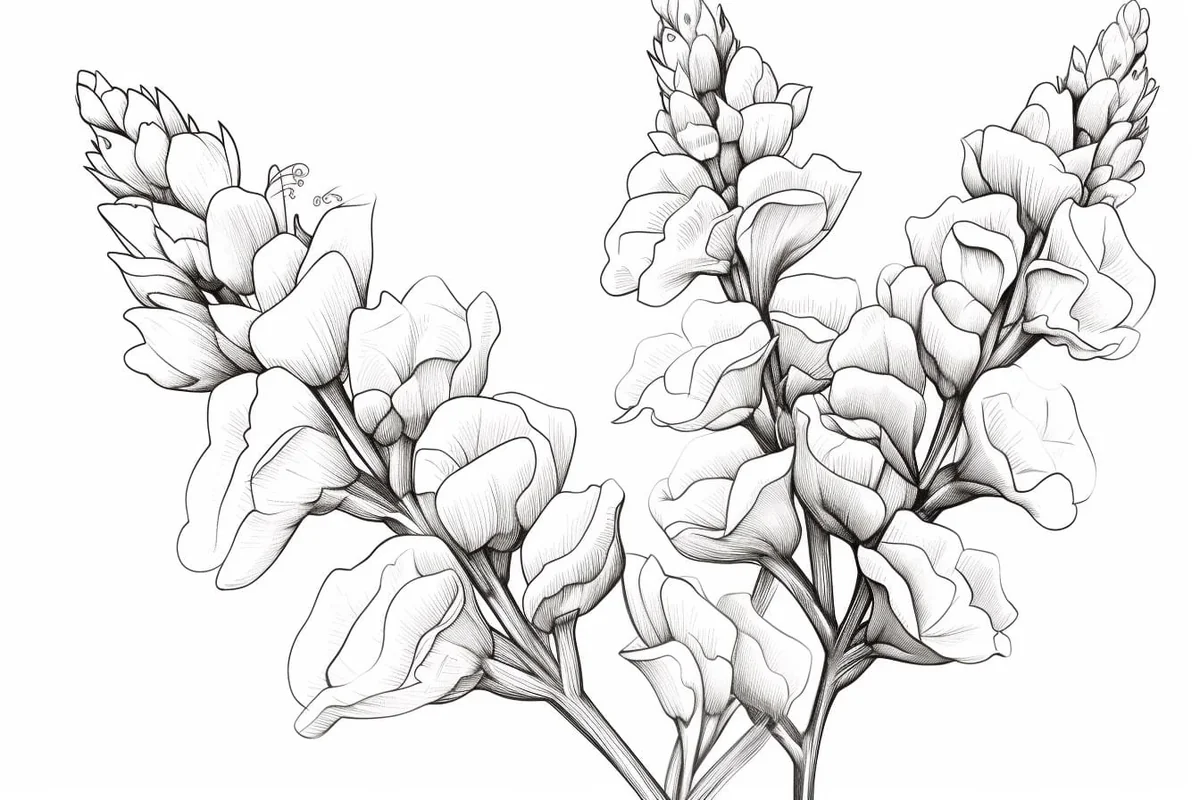How to Draw a Snapdragon in 8 Easy Steps
Learn how to draw with this step-by-step tutorial.

Materials You'll Need
- Drawing paper
- Pencil (HB or 2B)
- Eraser
- Colored pencils
- Markers
- Blending stump
- Watercolor paints

Welcome to our comprehensive guide on drawing the exquisite snapdragon flower! Known for its vibrant hues and striking appearance, the snapdragon is a captivating subject that appeals to artists of all levels, from beginners to seasoned professionals. These flowers, with their unique structure and variety of colors, offer a wonderful opportunity to enhance your drawing skills while also bringing a touch of nature's beauty to life on paper.
In this step-by-step tutorial, we will carefully walk you through the process of how to draw a snapdragon. Our approach breaks the task down into manageable steps, ensuring that you can follow along with ease, regardless of your current skill level. With clear instructions and helpful tips, you'll be able to express your creativity while accurately capturing the delicate features of this beloved flower.
Before you dive into your artwork, gather your drawing materials, and prepare for an engaging artistic journey. Let's get started on this colorful adventure—your snapdragon masterpiece awaits!



Materials Required
Before we begin, make sure you have the following materials:
-
Fine-tipped pens or markers (optional)
-
Colored pencils or markers (optional)
Now that we have our materials ready, let's dive into the step-by-step process of drawing a snapdragon.
How to Draw a Snapdragon: A Step-by-Step Guide
**Step 1: Sketch the Vertical Structure **
Begin by lightly drawing a vertical line in the center of your page. This will act as a guide for the stem and help maintain symmetry as you build the flower.
-
Near the top of this line, sketch a small circle—this represents the base of the first blossom.
-
You can also lightly mark a few points down the stem to indicate where future buds or blooms will go.
Use light pencil pressure so these guide lines can be erased later.
**Step 2: Shape the Main Petals **
From the top circle (the flower base), begin sketching the main petal shapes. Snapdragon petals are often curved outward and upward, almost like flared tubes or open lips.
-
Draw two arched, curved lines coming from either side of the base. These form the top set of petals.
-
Beneath them, sketch another pair curving slightly downward to suggest the lower petals.
-
Leave space between the top and bottom petals—snapdragon blooms are naturally open with visible gaps.
Think of the blossom as having a "mouth-like" shape with layered petals.
**Step 3: Add Ruffled Edges and Curves **
To give the petals texture and life, draw small scalloped or curved lines along the petal edges.
-
Add gentle, wavy lines to the outer contours of each petal, giving them a ruffled, soft appearance.
-
You can also add slight fold lines on the surface of the petals for extra depth.
No petal is perfectly smooth—use gentle variations to make your flower feel more organic.
**Step 4: Draw the Sepals **
At the base of the flower, sketch the sepals—these are the leaf-like structures that cradle the bloom.
-
From the bottom of the flower, draw a V shape with soft, curved lines extending outward and slightly downward.
-
Add a few overlapping lines to suggest multiple sepals wrapping around the stem.
-
Repeat this shape on the opposite side to show symmetry.
Sepals provide a nice contrast to the rounded petals with their more pointed, leaf-like forms.
**Step 5: Extend the Stem and Add Leaves **
Continue the stem downward from the base of the bloom.
-
Use a single vertical line, then double it into a thin, gently curving stem.
-
Add slight diagonal or broken lines along the stem to give it texture.
-
Draw leaves coming off opposite sides of the stem—each leaf should be elongated with pointed ends, and may gently curve outward or upward.
Snapdragon leaves are narrow, so avoid making them too thick or wide.
**Step 6: Add Buds Along the Stem **
Snapdragons grow in clusters, with unopened buds forming above and below each bloom.
-
Draw small oval or teardrop shapes at various points along the stem.
-
Angle them slightly outward and upward to reflect their position on the stalk.
-
Add small sepals beneath each bud, cradling the base.
Vary the size and angle of the buds for a more natural look.
**Step 7: Add Final Details and Texture **
Now that your main structure is in place, go back and refine the shapes.
-
Clean up any overlapping lines or guide marks.
-
Emphasize edges and shadows using soft, directional strokes.
-
You can add gentle shading inside the petals, along the folds, or where parts of the flower overlap.
If desired, use a fine-tip pen to outline key lines for a bold, polished look.
**Step 8: Add Color (Optional) **
Bring your snapdragon to life with color!
-
Petals: Use soft pinks, purples, yellows, reds, or even multicolored tones. Snapdragons come in a wide variety of colors!
-
Leaves and stem: Use light to mid-tone greens, adding deeper greens or browns for shadows.
-
Buds: Blend lighter hues at the top and deeper tones near the base to suggest growth.
Use layering and blending to create soft transitions, especially for petals and shadows.
**Conclusion: Your Snapdragon is Complete! **
Congratulations! You've just drawn a beautiful snapdragon, complete with intricate petals, elegant leaves, and delicate buds. With each step, you've practiced observation, structure, and stylization—important skills for any botanical artist.
Snapdragons make a wonderful addition to floral scenes, greeting cards, or nature studies. Try drawing them in bunches, pairing them with other flowers, or experimenting with fantasy color schemes. The more you practice, the more confident and creative your drawings will become.
Now go ahead and fill your sketchbook with blooming beauty—happy drawing!
Gallery of Snapdragon Drawings



Fun Facts About Snapdragons
-
Snapdragons get their name because their blooms resemble a dragon's mouth—and if you gently squeeze the sides, they even "snap" open like jaws.
-
In ancient times, snapdragons were believed to have magical powers and were thought to offer protection against curses and evil spirits.
-
These flowers come in nearly every color except true blue, and they often feature multiple shades on a single blossom.
-
Snapdragons are native to rocky areas of Europe and North Africa and thrive in cool weather, especially spring and fall.
-
In the language of flowers, snapdragons symbolize grace under pressure and strength, thanks to their ability to grow in tough conditions.
-
Snapdragons are pollinated primarily by bumblebees, whose size and strength are perfect for opening the flower's "dragon mouth."
-
The flowers are arranged in tall spikes and bloom from the bottom up, making them a favorite in cut flower arrangements and garden borders.
-
Snapdragons are short-lived perennials in warm climates but are often grown as annuals in cooler zones.
-
When dried, the seed pods of snapdragons take on a spooky skull-like appearance, which has made them popular among Halloween gardeners and folklore fans.
-
Snapdragons have been hybridized extensively, resulting in dwarf, trailing, and giant varieties that suit nearly any garden or pot.
Thanks! Based on the available post titles from Yonderoo-All-Published-Posts-20250418.csv, here is the revised "Suggestions for Scenes and Settings for Snapdragon Drawings" section with naturally embedded internal links:Tip: To capture the unique form of the snapdragon flower effectively, start by using a light pencil for your initial sketch—this allows for easy adjustments as you refine your drawing. Focus on the flower's shape, noting how the petals overlap and the way they curve; using reference images can greatly aid in understanding their structure. Once you're satisfied with the outlines, switch to colored pencils or watercolors to add vibrancy, layering colors to achieve depth and realism. Don't forget to pay attention to the highlights and shadows, as these will bring your snapdragon to life. Lastly, take breaks to step back and assess your work from a distance; this will help you see any areas that may need more attention or refinement.
Suggestions for Scenes and Settings for Snapdragon Drawings
-
Fairy Garden Pathway: Draw a trail of snapdragons lining a cobbled path through a whimsical fairy garden filled with tiny mushrooms, sparkles, and soft morning light.
-
Bumblebee Mid-Flight: Illustrate a plump bumblebee hovering in front of a blooming snapdragon, about to dive into the flower's open "mouth." You can practice by learning how to draw a bee.
-
Magical Apothecary Shelf: Create a cozy shelf with jars, vials, and a bouquet of snapdragons—possibly glowing—set beside a bubbling cauldron or magical ingredients.
-
Snapdragon Skull Garden: Show a twilight garden where dried snapdragon seed pods resemble tiny skulls. The shadows and shapes could echo those found in a haunted forest scene.
-
Color Explosion Bouquet: Draw a vivid bouquet with snapdragons in oranges, pinks, and yellows bursting from a vintage watering can or teacup.
-
Castle Courtyard: Place your snapdragons blooming in the cracks of an ancient stone castle wall, with moss creeping over the cobblestones.
-
Spring Festival Parade: Illustrate a parade scene where people wear flower crowns, with banners strung between snapdragon-covered arches.
-
Witch's Garden at Dusk: Draw a witch's herb patch featuring snapdragons glowing softly beside lavender, herbs, and moonlit lanterns.
-
Overgrown Greenhouse: Picture a forgotten greenhouse where snapdragons bloom through broken panes and curl around rusty tools.
-
Children's Storybook Meadow: Show a sunlit meadow full of wildflowers—especially snapdragons—with a child doodling in a storybook sketchpad, lost in their imagination.